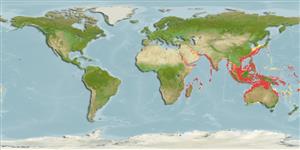Issue
Species spelling Eschmeyer, pers. comm.
Environment: milieu / climate zone / depth range / distribution range
Ecología
marino asociado a arrecife; rango de profundidad 7 - 200 m (Ref. 11298). Tropical
Indo-Pacific: East Africa, throughout the Indian Ocean to the Indo-Australian Archipelago and New Caledonia, north to southern Japan.
Tamaño / Peso / Age
Maturity: Lm ? range ? - ? cm
Max length : 15.0 cm TL macho / no sexado; (Ref. 11298); common length : 10.0 cm TL macho / no sexado; (Ref. 3322)
Radios blandos dorsales (total) : 81 - 87; Radios blandos anales: 61 - 65; Vértebra: 24. This species is distinguished by the following characters: body deeply ovoid; caudal fin with a pair of black blotches, arranged between the third and fourth fin rays from upper- and lowermost rays in the fin; the ocular-side pectoral fin is not elongate, and no sexual differences in its length; gill rakers are very short, not serrate (Ref. 126076).
Description. D 81-87; A 61-65; pectoral-fin rays on ocular-side 10-12, blind-side 8-10; caudal-fin rays 3 + 11 + 3; pelvic-fin rays on ocular-side 6, blind-side 6; lateral line scales 40-45; gill rakers 0 + 5-7; vertebrae 10 + 14 (Ref. 126076).
Found on sandy and muddy areas of the continental shelf. Feeds on crustaceans, polychaetes, and other benthic animals (Ref. 9824). Marketed fresh and sometimes dried (Ref. 9824).
Life cycle and mating behavior
Madurez | Reproducción | Puesta | Huevos | Fecundidad | Larva
Amaoka, K., E. Mihara and J. Rivaton, 1993. Pisces, Pleuronectiformes: Flatfishes from the waters around New Caledonia. - A revision of the genus Engyprosopon. p. 377-426. In A. Crosnier (ed.) Résultats des Campagnes MUSORSTOM, Volume 22. Mém. Mus. natn. Hist. nat. (158):377-426. (Ref. 9558)
IUCN Red List Status (Ref. 130435: Version 2024-1)
Threat to humans
Harmless
Human uses
Pesquerías: comercial
Herramientas
Special reports
Download XML
Fuentes de Internet
Estimates based on models
Preferred temperature (Ref.
123201): 21.2 - 28.3, mean 26.8 °C (based on 1099 cells).
Phylogenetic diversity index (Ref.
82804): PD
50 = 0.5000 [Uniqueness, from 0.5 = low to 2.0 = high].
Bayesian length-weight: a=0.00933 (0.00541 - 0.01611), b=2.98 (2.83 - 3.13), in cm total length, based on LWR estimates for this species & (Sub)family-body (Ref.
93245).
Nivel trófico (Ref.
69278): 3.1 ±0.0 se; based on diet studies.
Resiliencia (Ref.
120179): Medio, población duplicada en un tiempo mínimo de 1.4-4.4 años (Preliminary K or Fecundity.).
Fishing Vulnerability (Ref.
59153): Low vulnerability (10 of 100).
Nutrients (Ref.
124155): Calcium = 79.5 [29.8, 152.9] mg/100g; Iron = 0.613 [0.289, 1.093] mg/100g; Protein = 17.8 [16.3, 19.4] %; Omega3 = 0.0965 [, ] g/100g; Selenium = 36.4 [18.2, 74.5] μg/100g; VitaminA = 86.1 [21.1, 354.2] μg/100g; Zinc = 1.33 [0.86, 1.92] mg/100g (wet weight);
